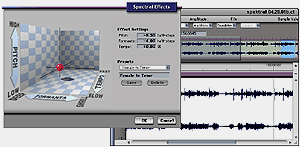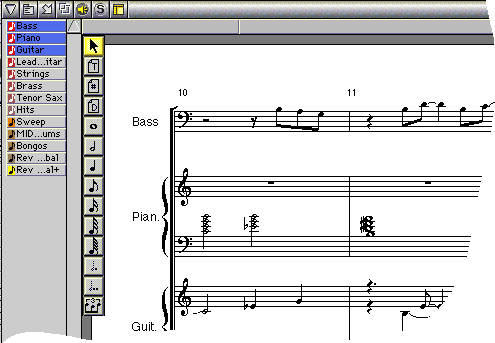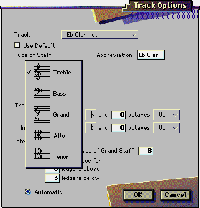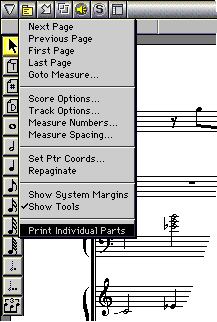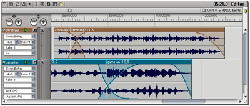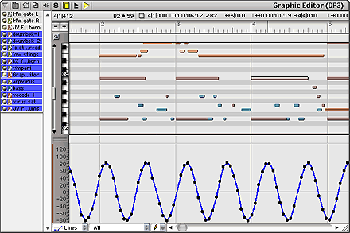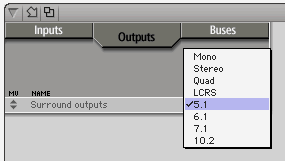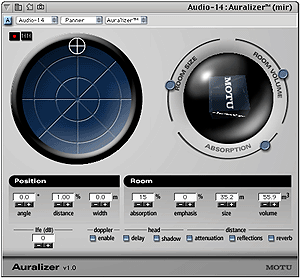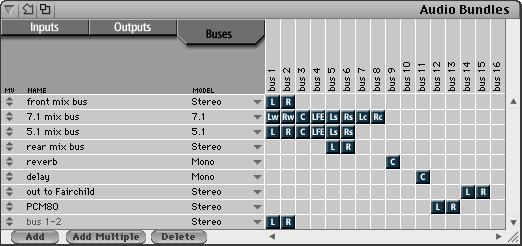FUTURE STYLE
|
Now available as a free download to all Version 4.5x users, Digital Performer 4.6 New features: Pitch Automation. Pattern Gate Plug-in. V-Racks. AAF file interchange. Film/Video Scoring Enhancements. Multiple outputs for AU plug-ins & ReWire. Audio Click. Bounce to QuickTime Movie. Productivity Enhancements. Download update (.zip) |
|
Digital Performer 4.0 (DP4) for Mac OS X released |
|
MOTU MARKOFTHEUNICORN 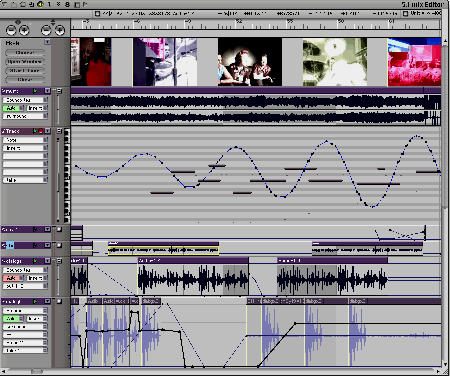 _____ Digital Performer _____ integrated digital audio and MIDI sequencing production system Environment for editing, arranging, mixing, processing and mastering multitrack audio projects for a wide variety of applications. for Mac OS X 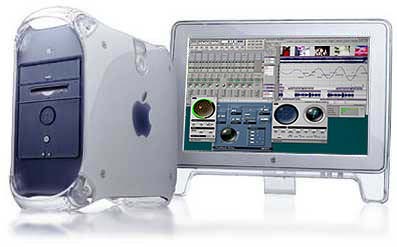 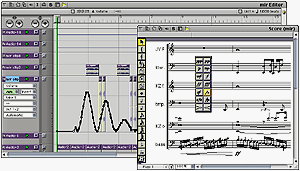 Unlike other audio applications, Digital Performer does not place artificial restrictions on the number of tracks you can work with. Unlimited audio and MIDI tracks means Digital Performer is ready for as many tracks as your hardware will allow. Digital Performer supports a wide range of audio hardware including TDM (Pro Tools), Direct I/O, ASIO, Sound Manager and Motu range of audio interfaces. Digital Performer supports high resolution 24-bit/96kHz audio. |
|
Tracks 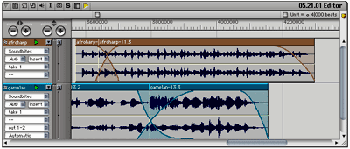
Digital Performer places no limits on the number of tracks you can use simultaneously and support mono, stereo and surround (n-channel) tracks. The maximum number of tracks you can play back at a time depends primarily on how fast your hard drive is and how much RAM you have. For example, 64 megabytes and a reasonably fast hard drive should provide 16-20 independent tracks of audio high-quality/ per/ '. Digital Performer's Bounce to Disk feature gives you an unlimited number of audio tracks by letting you non-destructively combine them into a single track or stereo track pair. Need to hear 100 audio tracks at one time? No problem. Bounce them down. Original tracks are always preserved, so you can go back and tweak them if needed.
Mixing View your MIDI and audio tracks in a single, unified mixer. Configure up to twenty effects inserts per audio channel, and 32 stereo busses. Everything is automatable, including effects parameters with five advanced automation modes, beat-synchronized effects and sample accurate editing of automation data. The automation system features a rich set of user interface technologiessuch as event flags for discrete events and spline tools for manipulating control points. Automation parameters are displayed in meaningful real world values such as decibels and milliseconds. Automated Mixing for MIDI & audio Configure your mixing board with up to 32 stereo sends, and 20 insert slots per channel. Audio Effects Digital Performer provides dozens of real-time, automatable 32-bit plug-ins, with graphical control including reverb, dynamics processors and EQ. Use the effects as an insert, on a single channel, or via a send/receive bus.The number of effects you can apply at any one time depends only on the speed of your computer. There is no built-in limit : the faster your Macintosh, the more effects you can use at one time.
Effects
Digital Performer includes dozens of real-time DSP-effects with easy to use graphical controls and complete automation. You'll find two, four and eight band EQ, tube-simulation and distortion effects with the PreAmp-1 plug-in, three reverbs, two noise gates including the MasterWorks Gate with real time lookahead gating, two compressors, a synthesizer-style multimode filter, echo & delay effects including a surround delay, chorus, phaser, flanger, the incredible Sonic Modulator and more. Digital Performer supports multiple processors so if you have a dual processor CPU, you get nearly twice as much processing power as a single processor. Digital Performer's multiple processor engine is fully compatible with all MOTU Audio System plug-ins (those from third party too).
Sample editing Digital Performer includes a built in waveform editor that provides editor tools as a pencil for removing clicks and a loop tool for defining loops for your sampler. Plus advanced features such as auto edit crossfades. The sampler integration allows you to transfer audio from your project to your sampler with a simple drag and drop operation. Because your sampler appears as a device inside Digital Performer, you can seamlessly share data. Digital Performer's PureDSP functions provide independent control over the duration and pitch of audio files with high sound quality. Also supported Premiere-format plug-ins. An effect can be applied directly to an audio file. Both PureDSP and off-line audio processing occurs in the background so you can continue working.
Waveform Editor Complete, fully-integrated 24-bit waveform editor. Zoom in to the sample level to see exactly what is going on in your audio. Use the pencil tool to permanently remove clicks and pops from your audio files. Edit soundbite boundaries with single-sample accuracy. View mono or stereo soundbites at any zoom setting you like. Automatic crossfades Digital Performer can automatically apply crossfades (of any length you specify) any time you cut, copy, paste, splice and otherwise edit your audio files. Sampler waveform editing integration Drag & drop sampler, define a region of audio from your Digital Performer project, edit it, trim the edges with sample level precision, specify loop points, normalize, fade in & fade out and send it to your sampler, without ever leaving Digital Performer.
Editing & MIDI
Edit MIDI with a resolution of 1/10,000.000 PPQ (pulses per quarter). When used with a USB MOTU MIDI interface, Digital Performer provides MIDI timing resolution to within a single MIDI byte &endash; under 1/3 of a millisecond ). With Multirecord MIDI recording, you can record on an unlimited number of MIDI tracks simultaneously. Three continuous controller editing modes for creating continuous controller streams for the automation of MIDI instruments. Movie track and Quicktime support integrates Digital Performer with the video world, enabling you to see instantly how your edits relate to picture. Individually zoomable tracks, flexible window arrangement, and navigation tools, for large projects too. Editors Event List, Drum Editor and QuickScribe notation. List-editing, or graphical style display; score lay-out, or extensive drum-programming; fine-tuning of single MIDI events, or massive changes of entire sections. QuickScibe notation window lets you print out the whole score or individual parts. Continuous scrolling moves the music under the wiper which stays fixed to the center of the window. Digital Performer's QuickScribe notation window provides multi-staff notation transcription of MIDI tracks for viewing, editing and WYSIWYG (whatyouseeiswhatyouget) printing. The notation transcription algorithms introduced in FreeStyle is in Digital Performer too. Play and get the accurate transcription available. Instantly. Advanced features include floating split points, multiple voices per staff, and n-tuplet recognition. The Straighten Swing feature displays swung eighths as straight eighths (instead of triplets). New Adjust Beats feature lets you graphically drag beats and barlines to line them up with MIDI note data.
Editing You can: Graphically draw volume automation curves. Pan sounds left to right. Loop recordings too; all as your music plays. Select only the tracks you want to see or show them all. Zoom in to work on fine details or zoom out for a wide overview. Drag, copy and paste digital audio "soundbite" regions just like MIDI data. From simple dialog editing to complex restructuring of large compositions with Lego blocks. Re-size soundbites by dragging their edges. Scrub digital audio to find exact start and end points for edits. Split and trim soundbites to work with smaller regions. Strip Silence works just like a noise gate with adjustable threshold, attack & release. The crossfade feature eliminates unwanted clicks and pops. Copy and paste regions to repeat verses or sound effects. "Drag and drop" audio regions from the soundbites window to any editing window for intuitive placement. All of these operations are nondestructive so you can always revert back to your original recording. Record and insert volume and pan effects. Even import material from your favorite sample CD-ROMs, then use any of Digital Performer's editing functions to customize them for your music. Digital Performer combined with a Digidesign recording system can be used as sampler. Palette tools include: arrow cursor, pencil, waveform tool, waveform selector, rhythm brush (for painting percussive patterns in the Drum Editor), magnifying glass, loop insert, and scrub. These tools now operate across all applicable windows. If a tool does not apply to the currently active window, it grays out. Automation/controller data drawing Digital Performer provides the following tools for inserting and modifying audio automation data and MIDI continuous controller data: flat line, straight line, parabola curve, spline (with adjustable control point), free and random, as well as the following periodic waveform tools sine, triangle, sawtooth, and square. You simply choose the desired tool and drag across the track in any graphic editor. Hot keys provide on-the-fly adjustment of period, amplitude, phase and other waveform parameters. You can even snap periodic waveform to the edit grid. These tools are ideal for creating automation effects, controlling synthesizer parameters in real time and other tasks. Automation/controller graphical modifiers: scale, limit and otherwise modify data graphically with many convenient tools: straight line, curve, sine wave, square wave, triangle wave, sawtooth, random and free. MIDI controller editing modes Digital Performer now offers three ways to view and edit MIDI CC data: 1) DP's classic 'points' mode, 2) 'Vision-style' colored bars, and 3) audio-style breakpoint automation lines. Digital Performer interpolates new streams of CC data when you work with breakpoint automation lines. You can freely switch between CC edit modes at any time, and choose the desired mode independently for each MIDI track.
Multiple MIDI tracks can be edited and displayed in one Graphic Editor window . The notes for each track are displayed in the track's color. A track selector list is provided along the left edge of the window to show/hide tracks as desired. You can also choose to view each track in a separate Graphic Editor window. Side-by-side display of MIDI and audio track The Sequence Editor window provides combined viewing and editing of MIDI notes, audio soundbites, audio automation and MIDI controller data in one window along a single timeline. Independent vertical zooming Both MIDI and audio tracks can be independently resized vertically. Many zoom shortcuts are provided, including the ability to enlargeone track and automatically scale all other tracks to fit in the window.
 Movie track Digital Performer's Sequence Editor includes a QuickTime movie track that displays movie frames side by side with MIDI and audio data. Digital Performer displays more frames as you zoom in and fewer frames when you zoom out, so that frames are never obscured by overlapping one another. Complete MIDI graphic editing The Sequence Editor provides complete MIDI graphic editing in the same window with audio tracks. You can scale the vertical resolution and track height of each MIDI track on a per-track basis. Complete multitrack audio editing The sequence editor has all of the audio workstation features . In addition, you can scale individual audio track size, and even adjust the waveform height within each track. Stationary play head Digital Performer's "Continuous Scrolling" preference causes the playback wiper to stay anchored to the center of the window while the data in the window scrolls behind it. You can opt to view a moving wiper as in previous versions,if you wish. Wiper-centered zooming Digital Performer's playback wiper now serves as the anchor point for zooming (in and out). You can quickly zoom in to a specific location and then zoom back out, and the focus point always remains in view. This makes zooming much faster, even during playback and recording.
Surround Sound Digital Performer provides a choice of four panner plug-ins including a localizing room simulator. Each audio track can be assigned to any surround sound format, from LCRS up to 10.2. Sophisticated panning movements can be automated using Digital Performer's automation system. Include complete surround submixes or record the output of a surround reverb with surround tracks. Digital Performer provides a complete environment for creating surround recordings, start to finish. Surround feature highlights include: Open architecture Digital Performer supports mono, stereo, quad, LCRS, 5.1, 6.1, 7.1 and 10.2 surround formats. New formats (n.n) can be supported in future versions, as they become available. Independent surround panners per track Digital Performer allows you to choose any panner you want for any track, including third-party panners. You can mix and match panners across a multitrack project as desired. For example, you might choose a localizer panner for a sound effect track and a stereo panner for a stereo musical instrument track. Regardless of which panner you choose, you can control it with the surround panning dish directly in the track's channel strip in Digital Performer's Mixing Board window. Panners can also be opened as separate windows (just like a plug-in) by clicking a button in the track strip next to the track's surround dish, but they remained linked to the surround dish in the Mixing Board track strip. Therefore, you can choose any panner for a track, and then control it from one of two places: the panner window or the panner dish in the Mixing Board window itself. Four advanced panners plug-ins included: ArcPanner ( provides a large, hi-resolution surround panning dish), n-Panner (provides customary surround panning via Cartesian coordinates on a square grid), TriPan (provides three-knob positional panning with sophisticated, graphic three-way divergence control. TriPan allows you to make precise panning maneuvers along a diagonal path, for example, with complete control over the degree to which the sound bleeds into any speaker), Auralizer (allows you to localize a sound in space using psychoacoustic cues. The Auralizer is a room simulator where you can design the size and absorptive characteristics of the space you wish to place your audio, then place a sound precisely in that space) Intelligent stereo surround panning You can choose from several panning modes (mirror, parallel, asymmetric, balance and mono) to steer stereo signals in a surround matrix with a single automation pass. MacOS Input Sprockets support Digital Performer supports the standard MacOS Input Sprocket protocol. This allows you to connect a compatible USB joystick to your Power Macintosh and use it to control any MOTU or third-party surround panner. Surround track type The new surround track type allows you to record, edit and apply effects to multichannel tracks as easily as mono and stereo tracks. This allows you to bounce down a surround submix or record the output of a multichannel mic setup or print a multichannel reverb. Audio bundles Digital Performer's Audio Bundles window allows you to create "bundles" of inputs, outputs and busses. For each bundle, you choose a name and a set of physical inputs or outputs on your audio interface, or a series of busses within Digital Performer's virtual mixing environment. Then the bundle appears by name throughout Digital Performer wherever I/O or bus assignments are made. Bundles allow you to quickly rewire the internal routings of their project with a few mouse clicks, regardless of how many surround formats or other routing scenarios you use. You can create multiple output setups: from a simple, tape-deck-style 'direct line out' mode to advanced surround configurations.
|
advanced technologic sound magazine 2003 february issue 1112005 august issue 140
|
